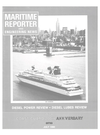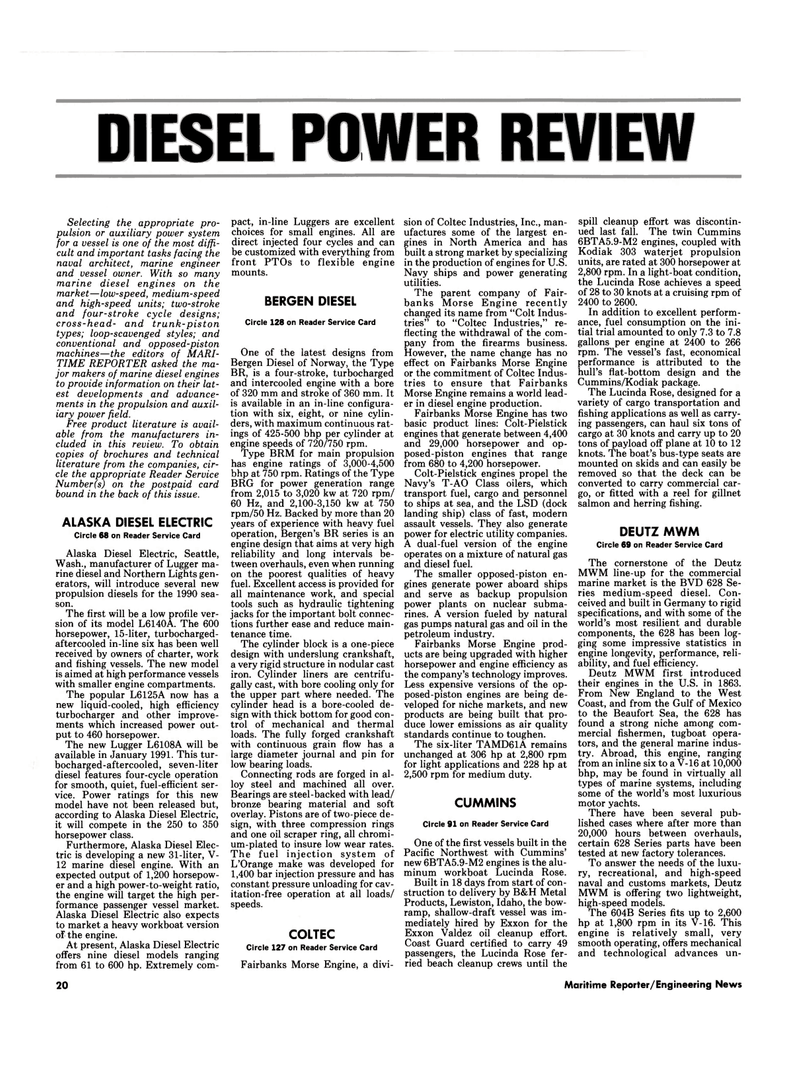
Page 19: of Maritime Reporter Magazine (July 1990)
Read this page in Pdf, Flash or Html5 edition of July 1990 Maritime Reporter Magazine
DIESEL POWER REVIEW
Selecting the appropriate pro- pulsion or auxiliary power system for a vessel is one of the most diffi- cult and important tasks facing the naval architect, marine engineer and vessel owner. With so many marine diesel engines on the market—low-speed, medium-speed and high-speed units; two-stroke and four-stroke cycle designs; cross-head- and trunk-piston types; loop-scavenged styles; and conventional and opposed-piston machines—the editors of MARI-
TIME REPORTER asked the ma- jor makers of marine diesel engines to provide information on their lat- est developments and advance- ments in the propulsion and auxil- iary power field.
Free product literature is avail- able from the manufacturers in- cluded in this review. To obtain copies of brochures and technical literature from the companies, cir- cle the appropriate Reader Service
Number(s) on the postpaid card bound in the back of this issue.
ALASKA DIESEL ELECTRIC
Circle 68 on Reader Service Card
Alaska Diesel Electric, Seattle,
Wash., manufacturer of Lugger ma- rine diesel and Northern Lights gen- erators, will introduce several new propulsion diesels for the 1990 sea- son.
The first will be a low profile ver- sion of its model L6140A. The 600 horsepower, 15-liter, turbocharged- aftercooled in-line six has been well received by owners of charter, work and fishing vessels. The new model is aimed at high performance vessels with smaller engine compartments.
The popular L6125A now has a new liquid-cooled, high efficiency turbocharger and other improve- ments which increased power out- put to 460 horsepower.
The new Lugger L6108A will be available in January 1991. This tur- bocharged-aftercooled, seven-liter diesel features four-cycle operation for smooth, quiet, fuel-efficient ser- vice. Power ratings for this new model have not been released but, according to Alaska Diesel Electric, it will compete in the 250 to 350 horsepower class.
Furthermore, Alaska Diesel Elec- tric is developing a new 31-liter, V- 12 marine diesel engine. With an expected output of 1,200 horsepow- er and a high power-to-weight ratio, the engine will target the high per- formance passenger vessel market.
Alaska Diesel Electric also expects to market a heavy workboat version of the engine.
At present, Alaska Diesel Electric offers nine diesel models ranging from 61 to 600 hp. Extremely com- pact, in-line Luggers are excellent choices for small engines. All are direct injected four cycles and can be customized with everything from front PTOs to flexible engine mounts.
BERGEN DIESEL
Circle 128 on Reader Service Card
One of the latest designs from
Bergen Diesel of Norway, the Type
BR, is a four-stroke, turbocharged and intercooled engine with a bore of 320 mm and stroke of 360 mm. It is available in an in-line configura- tion with six, eight, or nine cylin- ders, with maximum continuous rat- ings of 425-500 bhp per cylinder at engine speeds of 720/750 rpm.
Type BRM for main propulsion has engine ratings of 3,000-4,500 bhp at 750 rpm. Ratings of the Type
BRG for power generation range from 2,015 to 3,020 kw at 720 rpm/ 60 Hz, and 2,100-3,150 kw at 750 rpm/50 Hz. Backed by more than 20 years of experience with heavy fuel operation, Bergen's BR series is an engine design that aims at very high reliability and long intervals be- tween overhauls, even when running on the poorest qualities of heavy fuel. Excellent access is provided for all maintenance work, and special tools such as hydraulic tightening jacks for the important bolt connec- tions further ease and reduce main- tenance time.
The cylinder block is a one-piece design with underslung crankshaft, a very rigid structure in nodular cast iron. Cylinder liners are centrifu- gally cast, with bore cooling only for the upper part where needed. The cylinder head is a bore-cooled de- sign with thick bottom for good con- trol of mechanical and thermal loads. The fully forged crankshaft with continuous grain flow has a large diameter journal and pin for low bearing loads.
Connecting rods are forged in al- loy steel and machined all over.
Bearings are steel-backed with lead/ bronze bearing material and soft overlay. Pistons are of two-piece de- sign, with three compression rings and one oil scraper ring, all chromi- um-plated to insure low wear rates.
The fuel injection system of
L'Orange make was developed for 1,400 bar injection pressure and has constant pressure unloading for cav- itation-free operation at all loads/ speeds.
COLTEC
Circle 127 on Reader Service Card
Fairbanks Morse Engine, a divi- sion of Coltec Industries, Inc., man- ufactures some of the largest en- gines in North America and has built a strong market by specializing in the production of engines for U.S.
Navy ships and power generating utilities.
The parent company of Fair- banks Morse Engine recently changed its name from "Colt Indus- tries" to "Coltec Industries," re- flecting the withdrawal of the com- pany from the firearms business.
However, the name change has no effect on Fairbanks Morse Engine or the commitment of Coltec Indus- tries to ensure that Fairbanks
Morse Engine remains a world lead- er in diesel engine production.
Fairbanks Morse Engine has two basic product lines: Colt-Pielstick engines that generate between 4,400 and 29,000 horsepower and op- posed-piston engines that range from 680 to 4,200 horsepower.
Colt-Pielstick engines propel the
Navy's T-AO Class oilers, which transport fuel, cargo and personnel to ships at sea, and the LSD (dock landing ship) class of fast, modern assault vessels. They also generate power for electric utility companies.
A dual-fuel version of the engine operates on a mixture of natural gas and diesel fuel.
The smaller opposed-piston en- gines generate power aboard ships and serve as backup propulsion power plants on nuclear subma- rines. A version fueled by natural gas pumps natural gas and oil in the petroleum industry.
Fairbanks Morse Engine prod- ucts are being upgraded with higher horsepower and engine efficiency as the company's technology improves.
Less expensive versions of the op- posed-piston engines are being de- veloped for niche markets, and new products are being built that pro- duce lower emissions as air quality standards continue to toughen.
The six-liter TAMD61A remains unchanged at 306 hp at 2,800 rpm for light applications and 228 hp at 2,500 rpm for medium duty.
CUMMINS
Circle 91 on Reader Service Card
One of the first vessels built in the
Pacific Northwest with Cummins' new 6BTA5.9-M2 engines is the alu- minum workboat Lucinda Rose.
Built in 18 days from start of con- struction to delivery by B&H Metal
Products, Lewiston, Idaho, the bow- ramp, shallow-draft vessel was im- mediately hired by Exxon for the
Exxon Valdez oil cleanup effort.
Coast Guard certified to carry 49 passengers, the Lucinda Rose fer- ried beach cleanup crews until the spill cleanup effort was discontin- ued last fall. The twin Cummins 6BTA5.9-M2 engines, coupled with
Kodiak 303 waterjet propulsion units, are rated at 300 horsepower at 2,800 rpm. In a light-boat condition, the Lucinda Rose achieves a speed of 28 to 30 knots at a cruising rpm of 2400 to 2600.
In addition to excellent perform- ance, fuel consumption on the ini- tial trial amounted to only 7.3 to 7.8 gallons per engine at 2400 to 266 rpm. The vessel's fast, economical performance is attributed to the hull's flat-bottom design and the
Cummins/Kodiak package.
The Lucinda Rose, designed for a variety of cargo transportation and fishing applications as well as carry- ing passengers, can haul six tons of cargo at 30 knots and carry up to 20 tons of payload off plane at 10 to 12 knots. The boat's bus-type seats are mounted on skids and can easily be removed so that the deck can be converted to carry commercial car- go, or fitted with a reel for gillnet salmon and herring fishing.
DEUTZ MWM
Circle 69 on Reader Service Card
The cornerstone of the Deutz
MWM line-up for the commercial marine market is the BVD 628 Se- ries medium-speed diesel. Con- ceived and built in Germany to rigid specifications, and with some of the world's most resilient and durable components, the 628 has been log- ging some impressive statistics in engine longevity, performance, reli- ability, and fuel efficiency.
Deutz MWM first introduced their engines in the U.S. in 1863.
From New England to the West
Coast, and from the Gulf of Mexico to the Beaufort Sea, the 628 has found a strong niche among com- mercial fishermen, tugboat opera- tors, and the general marine indus- try. Abroad, this engine, ranging from an inline six to a V-16 at 10,000 bhp, may be found in virtually all types of marine systems, including some of the world's most luxurious motor yachts.
There have been several pub- lished cases where after more than 20,000 hours between overhauls, certain 628 Series parts have been tested at new factory tolerances.
To answer the needs of the luxu- ry, recreational, and high-speed naval and customs markets, Deutz
MWM is offering two lightweight, high-speed models.
The 604B Series fits up to 2,600 hp at 1,800 rpm in its V-16. This engine is relatively small, very smooth operating, offers mechanical and technological advances un- 20 Maritime Reporter/Engineering News

 18
18

 20
20
